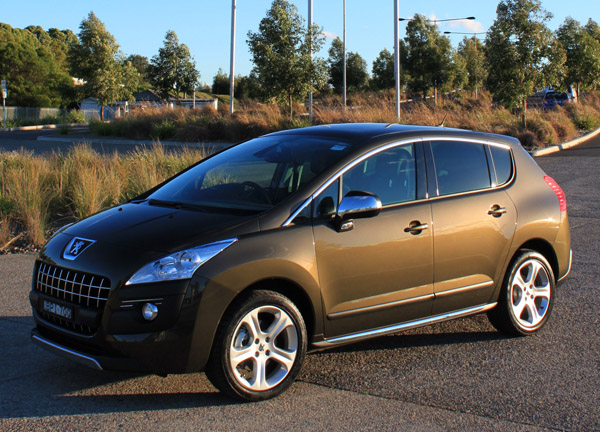
Peugeot is one of the world’s oldest car makers, dating back to the late 1890s. It’s a huge company in France and many other countries but hasn’t had the success in Australia it deserves.
Peugeot was a slow starter in the SUV field, believing it look would be a passing fad. However, it eventually realised these practical vehicles made sense and the 3008 was launched in France in early 2010.
Its styling is a crossover between the hard edged 4WDs and a classy looking wagon and it has launched Downunder in July 2010.
As a somewhat amusing side note: Peugeot is not allowed to call this car the three-double-oh-eight. After a protracted legal stoush with the owners of the 007 James Bond franchise the car maker has to refer to its 3008 as either three-thousand-eight, or three-thousand-and-eight.
It has chic French styling that works well both inside and out and we reckon that anyone looking for a sensible family vehicle that’s out of the ordinary should have the 3008 to their short list.
The added interior room and high driving position of the Peugeot 3008 was achieved by installing a different body on an extended Peugeot 308 hatchback platform.
The new generation 3008 was launched in mid-2017. Peugeot was under new management in Australia at that time so there was big marketing push on the all-new 3008. So, sales significantly increased. Combine that with better quality control in the factory and from these models onwards we feel you should aim for them if your budget is up to it.
The 2017 Peugeot 3008 has a fascinating latest-generation Peugeot i-Cockpit. This consists of a slim, programmable, 12.3-inch screen above the steering wheel. The wheel is tiny and features not only a flat bottom but a flat top. We love this setup, but some people may find that the screen is partly blocked by the wheel. Check this on your pre-purchase test drive.
Despite appearances to the contrary, Peugeot 3008 is a two-wheel drive vehicle (through the front wheels). Again, the French had anticipated the future, many of today’s latest SUVs are only 2WDs.
But a fascinating option is the Grip Control package that puts the 3008 into almost-4WD traction zone; 16-inch mud and snow tyres are part of the package. An example of the Grip Control is that the car deliberately spins its wheel at times to use the centrifugal forces to throw mud out of the tyre treads.
The 3008 has very-French ride comfort and long-legged cruising ability which makes it very well suited to Australian country conditions and driver desires.
The seating arrangements are very flexible with all passenger seats able to be folded flat, effectively creating a small van. The adaptable cargo area can be set at three different floor levels for extra security for various items.
Engine options are 1.6-litre turbo-petrol, 1.6-litre turbo-diesel and 2.0-litre turbo-diesel, though not all options are offered in every model.
On the downside, the turbo-diesel is mated to a six-speed self-shifting manual gearbox that sometimes displays the usual slow, rough changes felt from many gearboxes of this type. Try it for yourself during the pre-purchase stage, the problems are usually only at slow and parking speeds.
Slowish sales saw a cut back of the Peugeot 3008 range from up to 10 variants in March 2015, to just the entry-level Active specification with the choice of one petrol or one diesel engine, one transmission and a single option pack.
The number of Peugeot dealers in Australia is relatively limited. However, those who do look after the French cars have handled the marque for many decades.
Spare parts prices are about average for the class and we haven’t heard of any real problems with availability.
The 3008 is a relatively complex machine and while amateur mechanics can do some of the simple work, we recommend leaving most of the tasks to professionals.
WHAT TO LOOK FOR
Build quality isn’t as good as that of Korean and Japanese cars of this period, but has improved significantly in recent years.
Listen for squeaks and rattles inside when driving on a rough road, it doesn’t have to be unsealed, poorly maintained suburban ones can be used for the driving test.
Check the engine starts easily, diesels are slower than petrols but one that’s too bad may point to serious trouble.
Diesels are quite noisy in comparison to more modern designs in some competing vehicles.
Automatics are generally fine but if one seems erratic there could be troubles on the way. (See notes in the body of this review about the self-shifting manual.)
Make sure all the lights work, if a DRL has blown a globe it’s quite a big job to fix it as the front bumper has to be taken off.
Check for warning lights on the dash during your drive .
We’ve heard of instances where the tyre pressure monitoring system indicates there are problems when in fact there’s nothing the matter. Still best to stop and kick the tyres just in case, though.
Check the condition of the interior and the luggage compartment. For some reason owners of French vehicles often use them as load carriers.
HOW MUCH?
Expect to pay from $4000 to $70000 for a 2010 Peugeot 3008 XSE; $6000 to $9000 for a 2011 XTE or a 2013 Active; $8000 to $12,000 for a 2014 Allure; $10,000 to $15,000 for a 2015 Active Premium petrol; $12,000 to $18,000 for a 2015 Active Premium diesel; $15,000 to $22,000 for a 2017 Active; $18,000 to $26,000 for a 2017 Allure; $21,000 to $29,000 for a 2018 GT Line; $23,000 to $31,000 for a 2017 GT; and $36,000 to $47,000 for a 2020 GT.
CAR BUYING TIP
If possible, try to make your pre-purchase test drive on the sort of roads you will routinely be using it on.
RECALLS: To browse recalls on all vehicles go to the ACCC at: www.productsafety.gov.au/products/transport/cars/